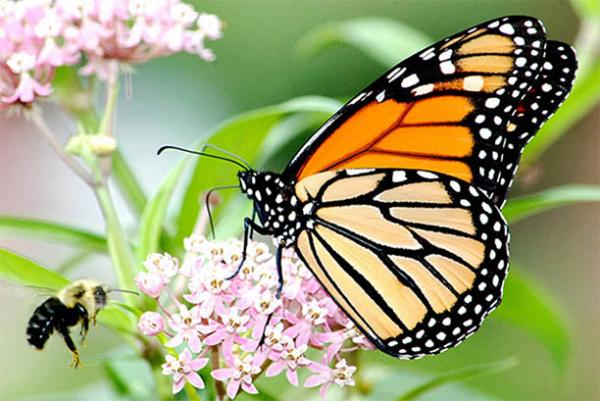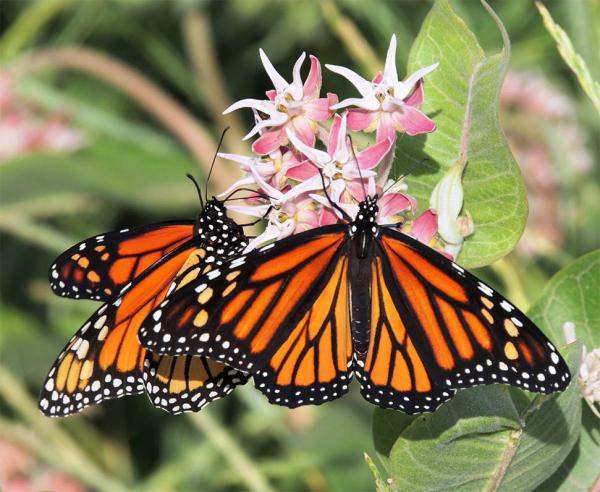Other than occupying a role near the bottom of the food chain, monarch butterflies don't appear to serve much purpose. Still, one would be hard-pressed to find another insect that is held in such high esteem by so many. After all, what other bug will little kids let rest on their fingers or noses?
 They also are endangered primarily because of loss of habitat and milkweed, the lone food source for monarch larvae. And golf course superintendents and others in the green industry are in a unique position to help, says Dan Potter, Ph.D., entomologist at the University of Kentucky. Potter is overseeing research by master's candidate Adam Baker on developing protocols for establishing milkweed as a food source for monarch larvae.
They also are endangered primarily because of loss of habitat and milkweed, the lone food source for monarch larvae. And golf course superintendents and others in the green industry are in a unique position to help, says Dan Potter, Ph.D., entomologist at the University of Kentucky. Potter is overseeing research by master's candidate Adam Baker on developing protocols for establishing milkweed as a food source for monarch larvae."Monarchs are an iconic and beloved species," Potter said.
"There are thousands of citizen scientists interested in helping monarchs. Why do they do this? Monarchs really don't have any economic value, and they are not important pollinators like bees. They don't really help crops in any way. . . They are a symbol of environmental health. They're like pandas in China, or polar bears or bald eagles. What good do they do? But it's special when you see one. And we don't want to lose them."
Monarchs are found throughout much of North America, including as far north as Canada. Colonies east of the Rocky Mountains migrate annually to Mexico. Those colonies west of the Rockies typically migrate to the central coast of California.
Habitat loss in Mexico is occurring at a staggering pace due to logging interests there. Milkweed populations are being wiped out thanks to development as well a preponderance of herbicide-resistant crops.
"Farmers are planting these transgenic crops and they can then overspray the whole field with glyphosate, and that kills the milkweed," Potter said.
Even adult females, which feed on nectar-producing flowers, need milkweed as a place to lay their eggs
"They follow the milkweed as a stepping stone as they migrate to and from Mexico. The loss of milkweed is threatening their populations, as is the loss of overwintering habitat in Mexico to logging. Virtually all the monarchs go to a very small area. If the Mexican special interests log that area and take down all the trees, then there is going to be big-time problems for monarchs."
It gets golf courses on the right side of an environmental issue that a whole bunch of citizen scientists and gardeners feel passionately about."
The objectives of Baker's research that is funded by the USGA and is entitled Operation Monarch for Golf Courses, are:
> Evaluate seven species of native milkweeds for ease of establishment, growth characteristics, pest resistance, and usage by monarch larvae and bees in replicated trials.
> Evaluate methodology for establishing species of native milkweed in golf course naturalized roughs.
> Document effectiveness of golf course milkweed stands, with or without wildflowers, for attracting and sustaining monarchs, native bees, and honey bees.
> Help to encourage and promote golf courses for monarch butterfly conservation through outreach education, webinars, conferences, trade journal articles, and media releases.
Through his research, Baker hopes to develop easy-to-follow protocols for planting, establishing and growing milkweed that provide a much-needed food source and egg-laying waystation for the butterflies.
Potter and former UK graduate student Emily Dobbs were pioneers in Operation Pollinator research and established the first plots in the United States at the A.J. Powell Turfgrass Research Center at UK and at the Marriott Griffin Gate Golf Club just a few miles away down Newtown Pike.
Potter and Baker used the same seeding protocols established in Operation Pollinator research for their milkweed establishment, with dismal results.
That included verticutting, scarifying and other ways to help establish good seed-soil contact, but few milkweed plants grew out of that. Their research is showing much better success transferring seedlings established in greenhouse conditions, Potter said.
"One of the objectives is to look at protocols for establishing milkweed in naturalized roughs, because there aren't any protocols for how to do this," Potter said. "We have learned that it isn't as easy as throwing seeds around. We've had some failures this year, but we've learned a lot from that."
The next question is which milkweeds to establish, because they're not all the same.
There are eight species of milkweed native to the Lexington area. Some are more prolific breeders than others, and all, Potter said, have varying levels of appeal to monarch caterpillars. Through his research, Baker hopes to identify which types of milkweed are best for specific locations and how best to establish them.
"Something like a butterfly milkweed might look good in your garden, but it's probably not a very good milkweed for golf course naturalized roughs because it just stays where it is. It isn't very prolific, it's a low-growing plant and it doesn't really attract that many monarchs because of its small stature," Potter said. "Something like common milkweed, it spreads by tillering. You could put in a dozen plants in naturalized rough, and three years later you might have 200 plants. It will spread on its own. That's good and bad. You don't want that in your home garden, but it would be great for filling in a naturalized area on a golf course.
"We're trying to find out which are the most attractive to monarchs and which are most suitable. We've already seen that some of these milkweeds attract way more butterflies and we end up with way more eggs on them than others. And they vary in their quality for yielding larvae, and they also are very good for bees, so they do double-duty. Some are pretty useless for bees and some are freakin' bee magnets."
 Monarchs go through four generations per year, with each generation living no more than a two-three months as it progresses from egg to larva to pupa to adult. Females lay their eggs at the end of their lifecycle, which can occur just about anywhere on their route.
Monarchs go through four generations per year, with each generation living no more than a two-three months as it progresses from egg to larva to pupa to adult. Females lay their eggs at the end of their lifecycle, which can occur just about anywhere on their route.With four generations per year, getting a handle on monarch populations is like wrestling a cloud. It is easier, however, to get a handle on monarch habitat, which has decreased by 84 percent in the past 20 years, according to Monarch Watch, an awareness program at the University of Kansas.
That effort promotes monarch conservation awareness through a program that allows businesses, schools, civic groups and individuals can grow milkweed and be certified as a monarch-friendly waystation. To date, 17,230 waystations are registered throughout North America.
Among the registrants are entities like the Ohio Department of Natural Resources in Columbus; The Smithsonian National Zoo in Washington, D.C.; the Shedd Aquarium in Chicago; Rutgers University in New Brunswick, New Jersey; Mrs. Albertson's kindergarten class in Los Angeles; and 16 golf courses spread throughout the U.S. and Canada, including Kiawah Island Golf Resort in South Carolina.
Golf course superintendents are in prime position, says Potter, to play a lead role in helping the monarchs in their plight.
"For all the same reasons that golf courses are involved in the Audubon Cooperative Sanctuary program and Operation Pollinator, this fits perfectly. It's the same motivations," Potter said. "You can take areas out of play, turn them into wildlife habitat and now you have a multifunctional golf course where instead of being an eyesore that habitat now serves a function and hopefully members and players, if they see purple martin boxes and bat boxes and see a sign that says 'wildlife habitat' then they understand what is going on.
"It gets golf courses on the right side of an environmental issue that a whole bunch of citizen scientists and gardeners feel passionately about. If every golf course in the eastern United States could put in a quarter-acre of milkweed somewhere in an out-of-play area, that could make a really big difference as far as stepping stones. It's good for their environmental image, and it could actually be good for the monarchs."

